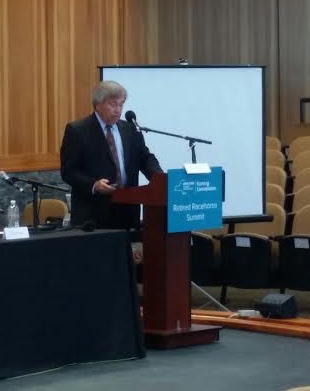
The Retired Racehorse Summit in Saratoga Springs this week concludes that the racing industry needs to dedicate more funds to retired racehorses.
As the fabled Saratoga Meet continued this week, talk of American Pharoah and other great horses was temporarily tabled as horsemen and industry leaders turned their attention to the welfare of retired racehorses during a daylong summit at Fasig-Tipton South Pavilion.
And on one point all 50-to-75 attendees could agree: More money is needed to ensure that no horse falls through the cracks when his racing days have ended, says Diana Pikulski, director of external affairs for the Thoroughbred Retirement Foundation.
Pikulski, who spoke at the summit, and who was a member of the New York State Task Force on Retired Racehorses, which was the precursor to the summit, says she felt “very encouraged” by what she heard.
“It’s great to see that the people who are mainstream and most deeply involved in horse racing and horse breeding are committed to solving the problem,” Pikulski says. She adds, “The key theme of the day, which everyone agreed to, was there is not yet enough money” available to adequately address the problem “and that there’s too much reliance on donations, and not enough commitment from the industry.”
That said, attendees and participants were “thrilled” that awareness and funding have grown over the last 10 years, Pikulski adds, noting that summit participants concurred that all racehorses have value as future sport and riding horses, and even the injured ones have value as therapy horses. “So there’s a job for them too in nontraditional places,” Pikulski says.
Prominent owner Jack Knowlton of Sackatoga Stable served with Pikulski and many others on the task force, and notes that the summit, which he kicked off, was an important next step, building on all the research that went into the 243-page task force report. The task force was created by the state legislature to identify productive uses for retired racehorses and increase the number available for such uses. The task force also was charged with finding “new and innovative methods that can utilize private and public funding sources to place retired racehorses” after their racing days are over, according to published reports.
Echoing Pikulski’s reaction to the summit, Knowlton acknowledged that while more funding is necessary to adequately safeguard retiring racehorses, positive developments are already starting to accrue.
Two pledges were announced at the summit:
• The New York Racing Commission announced a plan to match the $5 start fee paid by horsemen in New York racing, a pledge that amounts to $90,000,
• The Racing Commission also announced that as a condition to receive a license, owners and trainers will be required to watch a five-minute educational video on the life cycle of the racehorse.
“We brought just about every major player and racing organization to one place. People understand that there is a lot of good being done out there, but there’s a lot more to do, and funding is an issue,” Knowlton says. “This is not the end of the discussions.
Participants in this week’s summit were: Andy Belfiore, TAKE 2; David Brown, Finger Lakes Horsemen’s Association; Richard A. Violette, Jr., New York Thoroughbred Horsemen’s Association /Take The Lead; Madeline Auerbach & Lucinda Mandella, CARMA; Erin Crady, Thoroughbred Charities of America; Diana Pikulski, Thoroughbred Retirement Foundation; Stacie Clark Rogers, Thoroughbred Aftercare Alliance;
Sam Elliott, PARX; Christopher Kay, NYRA; Mike Rogers, Stronach Group; Mike Ziegler, Churchill Downs; Judith Bokman, Standardbred Retirement Foundation; Jeff Gural, Tioga & Vernon Downs; Ellen Harvey, USTA; Katherine Starr & Robin Young, Sunshine Horses;
Michael Blowen, Old Friends; Kim DeLong, Finger Lakes Thoroughbred Adoption Program, Inc.; Anna Ford, New Vocations Racehorse Adoption Program; Lisa Malloy, ReRun; JoAnn Pepper, Old Friends at Cabin Creek; Erin Pfister & Heather Carlson, Akindale Thoroughbred Rescue; Susan Wagner, Equine Advocates, Inc.




Great to read about raised awareness and funds! I know of so many OTTBs in Australia that are homed before their career slows; there is such a demand for them after racing.
I am not a horse owner or a trainer or anything but a horse lover. And I love horse racing, too. Why can’t a little bit out of the total purse of every race go into a fund of some sort set up for retired racehorses? If you have a four-month meet, race four days a week, and have nine races per race day, that is about 720 races. Multiply that by $100. That’s not much, but with good marketing and other resources, that could be rolled into a pretty penny. Just a thought, and maybe it’s already being done. I’m not an insider so I don’t know whether it is or not. I just know I think there could be a better concerted effort on the part of the tracks, horsemen, and horse retirement homes themselves so us lay people would have a better idea of what is going on and a better direction in which to point our help.
How can we keep up on next steps? And how do we join the advocacy effort? Susan, can you advise? Thank
Great Progress!